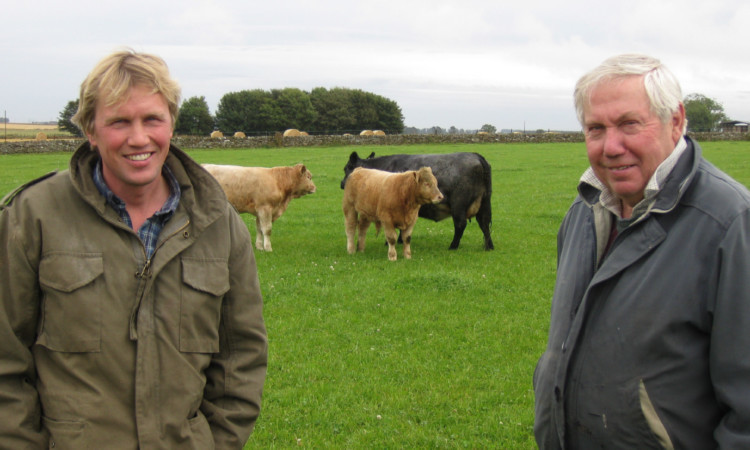The Porter family from Carnoustie have had cattle on their arable farm for over 50 years and have every faith in them continuing to be profitable whatever decisions are the future Common Agricultural Policy (CAP) are taken in Brussels.
Father and son Willie and James Porter, farm East and West Scryne and Carnegie in partnership, while Willie is also responsible for 7,500 acres of hill in Glen Lyon.
They believe the combination of hill and arable ground is ideal for their autumn calving suckler herd, while the spring calvers have their permanent base on the Carnoustie farms.
At a recent Quality Meat Scotland (QMS) Planning for Profit event in Perth, Willie Porter said much of the 900 acres of arable land at the coast is very light and requires grass in the rotation which fits in with the cattle enterprise.
And James Porter said: “We see considerable benefits in terms of cereal and potato yields from having grass and cattle in the rotation and we believe that the cattle are partly responsible for the fertility of the arable farm.”
They attribute much of their success to the Blue Grey cow which is economical to keep, long-living and hardy.
The average cow weight is 525kg and one of the key messages from the Porters’ experience with the herd is that you do not need to have large cows to produce decent-sized fast-growing calves provided that you look after the cows and choose the right bulls.
The neat cow size also offers the potential to stock more cows on a given area of land, resulting in highly efficient cows producing more kg of beef for a given area of land.
Replacements for the 100 autumn and 80 spring calving herds are purchased at Newcastleton.
James Porter said: “Blue Greys are incredibly healthy and fertile cows.
“We expect to get an average of nine calves out of them, which means depreciation is running at only around £30 per cow.”
Willie Porter said: “The autumn calvers are summered above 1,500ft at Glen Lyon and they are great foragers.
“They always come off the hill well-fleshed, fit and ready to calve down in September.”
This herd is outwintered on lighter fields at Scryne where three blocks of Bittern kale is grown with barley stubble run off.
Bittern is the variety of choice because it is slightly shorter and does not get too tall and fall over.
Willie said: “The cows and calves winter really well on the kale from November to March, each cow and calf unit will eat 30kg of kale per day.
“The calves are only creep-fed from the turn of the year.”
A Limousin bull is used on the heifers and three Charolais bulls on the cows, but thanks to the fertility of the Blue Grey, bulls are only in for nine weeks and calving percentage is always around 95% to finishing.
Willie continued: “I believe profitability lies in keeping a small cow for economy and using a big bull.
“We have few problems calving the Blue Greys which, although small, have a wide pelvis.”
The 2011 costing showed the Porters’ cows were making a net margin of £114-£113/cow up to weaning, after fixed costs had been deducted.
Potatoes, cereals and soft fruit are the mainstay of the business for the Porters but the cattle have an important part to play in utilising around 30 acres of land which is unsuitable for ploughing and the spring calving herd spends the whole year at the lowland farms.
They clean up after vegetables and potatoes before ploughing gets under way in January when they are housed to calve in February and March.
This is the only time cows and calves are inside and by April/May they are out to summer on permanent and temporary grass.
Willie said: “We have adapted our cattle enterprise to suit our arable farms but this could not be done everywhere.
“We have the ideal conditions for out-wintering cattle light land, low rainfall and very little frost.”
However, he was adamant the cattle have always paid their way by keeping the right type of cattle and managing them well.
James pointed out that having spring and autumn herds spread the fixed, labour and bull costs.
All the calves are finished on a barley beef system with bulls kept entire.
James said: “The bulls average 332kg live weight at weaning and are fed on an ad lib system until they are finished at an average of 14.2 months and 355kg dead weight.
“They are all sold to ABP, Perth and 80% make U grade.”
He said the average daily dead weight gain from birth to weaning for the bulls was 0.72kg, while the heifers, which are less intensively finished to 270kg at 16 months, average 0.46 daily dead weight gain with the majority making R grade.
Both Willie and James have confidence in the cattle business and Willie said: “I have always been a great believer in diversification and having a variety of enterprises on the farm because when one goes up another will come down.
“At the moment we cannot sell potatoes but can easily sell cattle.
“We would not have nearly 200 cows if they were not profitable.”
